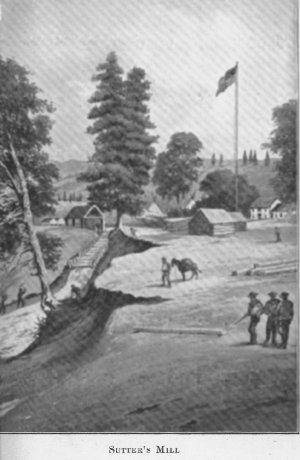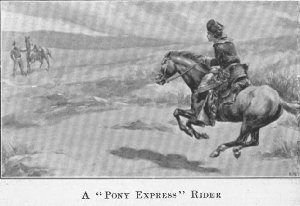THE COMING OF INDUSTRIES
The search for mineral wealth. Louisiana ignored for California. Later developments. The day of the "pony express." The great cattle industry. Opening of the interior by the first transcontinental railroad.
The treasure seeking of the Spaniards in the Southwest and various quests of the French belong to early history, but it was less than sixty years ago that Americans began to write the story of the mine in the West. A few pioneers knew something of the mineral riches of the West — trappers, scouts, fur hunters like Bridger, Ashley, or Peter Ogden famous in the annals of the Hudson Bay Company, or, later, William Sublette, Walker, and Kit Carson. These men had penetrated the mountains and knew the Great Basin. Some of them brought back tales of placer gold, and even showed specimens.
But it was not until 1848 that the age of gold was opened to Anglo-Saxons in the West. The digging of a mill race for J. A. Sutter at New Helvetia, California, brought the discovery of gold and the opening of one of the most eventful chapters in the record of the world’s pursuit of mineral wealth. The Argonauts who crowded vessels bound for the Isthmus or the Horn, or painfully traversed the well-worn trails1 from independence or St. Joseph, made a history of their own. The number of men in the California gold fields rose from a handful at the time of the discovery to six thousand at the end of 1848, and thirty-five thousand by the close of the following year. Not until 1855 was a railroad opened across the Isthmus of Panama, but in the first twelve years of its existence it carried eastward gold valued at seven hundred and fifty million dollars.

For this wonderful tide of overland migration the old Louisiana territory was but a country to be traversed. Yet the increased knowledge of the West had its influence, although the gold seekers neglected treasures which were developed later. The early fifties brought some beginnings of placer mining in Nevada and Utah, as did also the sudden and disastrous excitement over gold at Pike’s Peak. The later fifties witnessed the discovery of the stupendous Comstock lode in Nevada, which was followed within a few years by the disclosure of mineral riches hidden within the confines of Louisiana. In the early sixties came discoveries of gold in Idaho and Montana, and later copper was added to swell an output beside which the initial cost of Louisiana sinks into insignificance, without reckoning the products of Dakota, the zinc and coal of Missouri, or the other mineral resources of a land crossed by the Argonauts with eyes open only to the gold of the Pacific coast. The first placers of Colorado were followed by the long list of discoveries which have given such names as Leadville, Cripple Creek, and Creede a fairly historic character.
 |
In 1803 a month and a half was required for the transit of letters from the eastern seaboard to St. Louis. Half a century later the best time for government dispatches from the eastern border of the old Louisiana territory to California was three weeks. In 1859 St. Joseph, Missouri, was the most western railroad point, two thousand miles from California. There were only wagon trains and stages over thirteen hundred miles of trail to the mountains and seven hundred miles of mountain roads. The plains were held by hostile Indians. For those who shrank from the privations and dangers of the overland trail there was left a choice between the Isthmus route and passage around Cape Horn. The need of quicker communication with California, which had been felt since the migration of gold seekers began, was made more imperative by political conditions. Out of this need grew the "pony express." 2
At the outset, as at the outset of most new departures, the idea was ridiculed. It was deemed impossible that a successful mail service could be maintained by relays of single riders over two thousand miles of practically hostile country. But the government and business men assured the organizers of patronage. Some six hundred bronchos were purchased. A corps of seventy-five light-weight riders was enrolled, and relay stations were established at intervals of a hundred miles on the plains and forty miles in the mountains, each station equipped with a few men, several horses, and a generous supply of arms and ammunition.

At noon of April 3, 1860, came the opening of the "pony express" route, which was awaited on the Pacific coast with an interest second only to that caused by the driving of the spike which a few years later joined the Union and Central Pacific railroads at Promontory Point, Nevada. The pioneer rider started westward from St. Joseph, Missouri, followed by music and cheers, carrying a message from President Buchanan to the governor of California, with bank drafts, letters, and papers. The rider’s distance was a hundred miles, and then his mail bag was carried on by his waiting relief.
So the mail sped on, across plains and alkali deserts, through cañons and over mountain passes, through the lands of a dozen hostile tribes, until ten days later the last rider reached Sacramento and the President’s message was telegraphed to San Francisco. On April 3 also a rider started east from Sacramento with the first express pouch for the East, which went through to St. Joseph in eleven and a half days. This was the beginning of the "pony express."3 Every week day riders left St. Joseph and Sacramento. The charge for letters was five dollars an ounce, and later bonuses were paid for war news. The fastest time was in December, 1860, when President Buchanan's message reached Sacramento in eight and a half days from Washington. The news of the attack on Fort Sumter came through in eight days and fourteen hours — two thousand miles. On the western part of the route five riders were killed by Indians, two were frozen to death, and several were shot on the plains. One man, finding the Indians had killed every one at the relay station, rode two hundred and eighty-four miles without rest, averaging sixteen miles an hour. Another covered two hundred and eighteen miles with six horses, one of which carried him seventy miles at high speed. The "pony express" lived a life brief but crowded with thrilling episodes. It was ended in 1862, when the first telegraph line was built across the plains.
1"Along this line [the overland trail] the ‘prairie schooners’ stretched for miles. . . . A traveler counted four hundred and fifty-nine wagons in ten miles along the Platte. . . . The cholera epidemic of 1849 carried off over five thousand of these immigrants gathered along the Missouri." — Sparks’s "Expansion of the American People."
Return to text.
2 Of all the expresses, the most romantic and picturesque was the pony express, inaugurated by William H. Russell and B. F. Ficklin in 1860, absorbed later by Wells, Fargo & Co., and abandoned in 1862, when the telegraph line was completed across the continent."—" The Story of the Railroad," by Cy Warman.
Return to text.
3 "The Great Salt Lake Trail," by Colonel Henry Inman, and Mark Twain’s "Roughing It," afford some picturesque sketches of the "pony express."
Return to text.
Continue
Back to Legacy
© 2001, Lynn Waterman